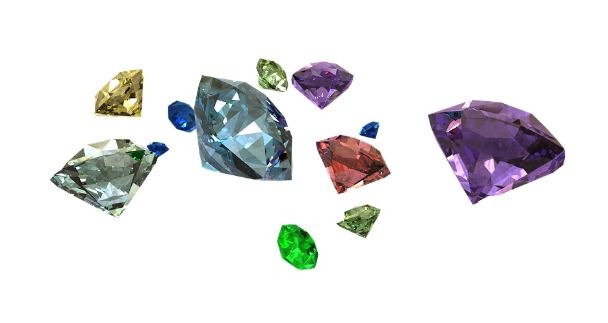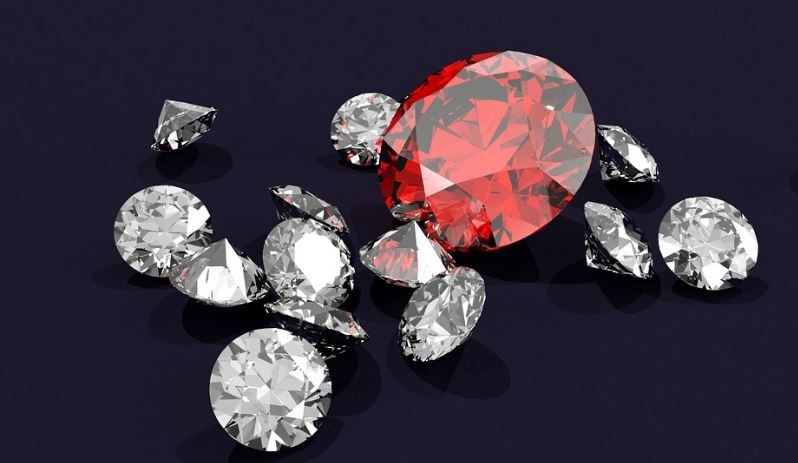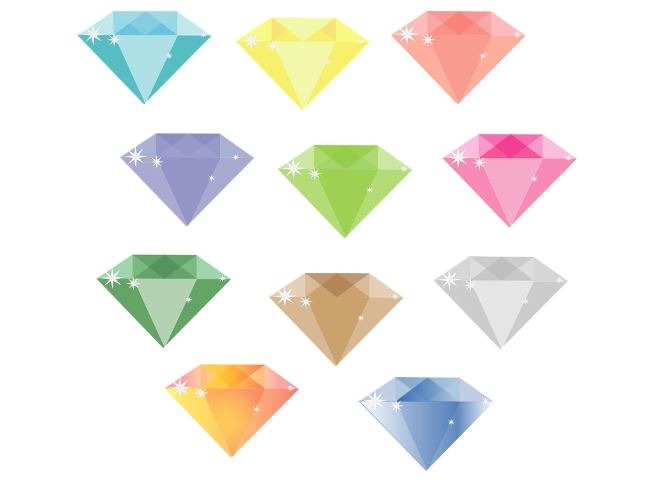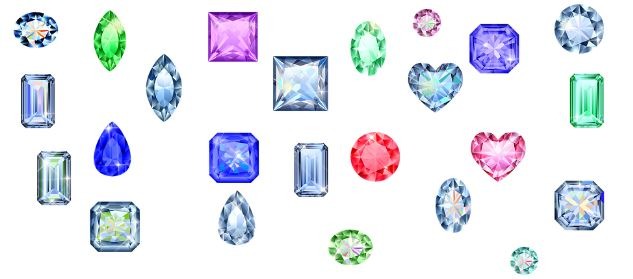Nobody wants a D on their report cards, but everyone would love to get diamond with a grade D! Wondering why? Hint: it is the best diamond hue amidst the rest.
What are colored diamonds? How are they formed? Are they different in price than a transparent one? All your queries will be answered right here. Scroll through and learn a lot of interesting and least known facts about different colors in diamonds.
Understanding 4Cs
Understanding 4Cs is the first thing you should be reading about before moving on to the main topic.
Gemological Institute of America (GIA) introduced the right way of diamond grading, which is still used as a standard in the gemstone industry. The grading is done on the basis of 4C, and in this equation the 4C stands for:
1. Carat
2. Clarity
3. Color
4. Cut
While purchasing diamonds; it is important to be aware of 4Cs to make your shopping experience fruitful, specifically for choosing diamond colors. That’s because buyers are more interested in cut or carat, and usually they are not able to notice diamonds with some tint in their structure in the very first glance. However, the shade of the precious stone can not just impact the value, but also its price in a noteworthy way.
The History of GIA Color Grading Scale
The popular diamond color grading scale by GIA was introduced back in 1953. Being used as standard now; the scale starts with D, instead of the usual A and progresses to Z.
Earlier, the jewelers would use comparisons to describe diamonds, like water, river, letters such as A, AA or AAA and numeric values. There came a time when people started selling a lot of jewelry. That is when Robert M. Shipley – a former retail jeweler saw the need of uniform standards for gemstone grading. In 1931, he founded GIA as a research and an education facility to study the precious metals, which was a revolutionary step in the jewelry industry.
Apart from GIA, Robert also established the American Gem Society for knowledgeable and professional jewelers in 1934.
Colored Diamonds Know-how
When we talk about colored diamonds, it refers to how yellow or clear the crystal is. Basically, diamonds with the highest quality are completely colorless, whereas low quality stones usually have a mild pale tint to them.
The color of this precious gemstone is measured with the help of GIA color scale that starts from D (colorless) to Z (brown or light yellow). Based on the color range, diamonds can be hugely priced. Therefore, before purchasing an engagement ring for your fiancé-to-be; you should be clear about the shade of the gemstone.
Don’t forget to check out the most famous diamonds in the world for some amazing ideas.
How Much Color Grading Matter While Purchasing Diamonds?
And the answer is, very much.
When it comes to distinct colored diamonds; blue, yellow and pink hues are not just extremely beautiful, but are equally pricey. However, in case of white diamonds, a yellow tint doesn’t look appealing. Why? Due to slight coloring in the crystal, less amount of natural color light will reflect back. The more transparent a diamond is, the more valuable, radiant and rare it will be considered. In short, the price of the crystal depends very much on the color grading.
Interested in knowing about unique engagement ring ideas? Click here.
Diamond Color Grading Chart
It is advisable to ask for a GIA certificate with every diamond you inspect. The following color scale will help you understand the concept of GIA grading better. Have a look:
Diamond Color Grade | Representation | Jewelry Setting |
D | It is known as the highest color grade. It appears colorless. Either you inspect it with a naked eye or use a magnifier for the purpose; you won’t see any tint or color in a D color diamond. | D color crystals goes well with white gold and platinum because yellow gold distracts the beauty of a colorless gem. |
E | This grade is considered ‘almost’ identical to the color D. In fact, at times it is hard to tell them apart. That’s when an expert gemological can be your savior! The professionals have special instruments to reveal even the slightest hint of color. | E color diamonds are also paired with white gold and platinum, like the previous ones, to prevent color distractions. |
F | D, E and F color diamonds seem identical to each other even if you check them under magnification or do a side by side comparison. It means no visible color is present. | Same setting as above. |
G | G color crystals have mild tints of color that can’t be detected with a naked eye. It is known as the best grade in GIA range of ‘near Colorless' diamonds. | Will look good with platinum and white gold. |
H | Although H color diamonds may seem colorless to the naked eye; however, it has a faint yellow hue which can be observed under magnification done in bright lighting. The range is more affordable as compare to the ones listed above because of the color. | Platinum and white gold. |
I | L color diamonds are a good value for money. They have a slight yellow tint to them, which can be seen if you do a side by side comparison with the highest color grade. | It goes well with white gold, platinum, rose gold and yellow gold as well. |
J | J color diamonds have a faint yellow tint in them that appears only under bright light or magnification. | Recommended for brilliant cut diamond sets in white gold and platinum. Not suggested for diamond shapes with fewer facets or larger table. |
K | This grade is classified as ‘faint tint' on GIA color scale. Its yellow tinge is even visible to the naked eye. | Will look gorgeous with yellow gold setting. Shouldn’t be paired with platinum or white gold. |
L | You can easily see the yellow hint of shade in L color crystal with a naked eye and even in a normal lightening. They are more affordable in comparison with G to J range. | Not suggested for non-round shape of diamond, platinum or white gold. Goes well with solitaire rings in yellow gold because of the warm tone. |
M | It has a definite yellow color, which makes the price of M color diamonds low and affordable as compare to colorless or near colorless diamonds. Typically, it is considered as the lowest color grade by diamond vendors. | Looks beautiful in antique yellow gold sets. |
N - R | Gemstones in this range have a yellow or brown tint in them. They can be bought in a much lower price. | Not suggested buying. |
S - Z | S to Z range diamonds have noticeable brown or yellow shades. | Not suggested buying. |
Distinct Colored Diamonds Scale
Color grading for fancy diamonds is different as they are graded on the basis of color intensity, ranging from faint to fancy deep. For instance, the scale goes as:
- Faint
- Light
- Very light
- Fancy
- Fancy Light
- Fancy Vivid, Fancy Deep or Fancy Dark
- Fancy intense
Have a look at the chart to find out the properties of distinct colored diamonds and how they are caused.
Color | Cause of Existence |
Pink | It is a rare and precious color in diamonds that occurs as a result of stress caused within Earth. The pressure displaces the carbon atom present in the diamond crystal, and when the light passes through it; red light is transmitted which appears pink due to weak transmission. P.S. Transmission is generally weak. Hence, red color is rare. |
Red | The color is quite rare in diamonds naturally. However, they are highly valuable in the purest form. Just like pink crystals; red diamonds are also subjected to stress, causing deformation in structure and atom displacement. The light passes through it appears red, in case of strong transmission. |
Orange | Another rare color in diamonds. The cause of existence of this precious gemstone is still questionable, and it may vary in every piece of crystal. However, it is believed that the defects in orange crystal are due to the blue light absorption, resulting in orange transmission. |
Yellow | This one comes to second number when we talk about most common natural color in diamonds. The hue is caused when nitrogen atoms substitute carbon in the structure of diamond. Upon blue light absorption; the gemstone selectively transmits yellow color. |
Green | Green color diamonds are formed when the radioactive mineral grains, present nearby, emit high-energy radiation that penetrates the diamond. As a result, the carbon atoms are displaced and defect cause the crystal to absorb red light and transmit green. Green diamonds can also be formed due to the presence of hydrogen, nitrogen or nickel within the crystal. |
Blue | The blue hue takes place when boron atoms substitute carbon atoms in diamond’s structure. Boron absorbs red light and transmits blue. |
Violet | When carbon is replaced with hydrogen; violet color is formed. |
Purple | Caused by the displacement of carbon atoms, purple color crystals are one of the rare diamonds to find. |
Brown | This one is the most common natural color found in diamond crystals. The color is developed because of plastic deformation and carbon atoms’ displacement in the structure of diamond. |
White | White color develops when the crystal has dense clouds of several reflective inclusions. These inclusions interfere in the light’s passage, giving an opalescent or a transparent appearance to the diamond crystal. |
Black | The extremely gorgeous black diamond is formed due to high mineral inclusions’ density that allows only a little light to pass through the gem. Black diamond’s common inclusions are: graphite, hematite and pyrite. |
Important note: The causes of color formation mentioned above are only some of many causes of color development in the diamond crystals. Various other defects are responsible for it. Moreover, a lot of people induce color in the gem through different treatments, like heating, coating and radiation.
Which Color of Diamond You Should Buy?
Well, it all depends on your budget!
Generally, diamond color is not the most significant factor while purchasing one. It is recommended to choose the desirable diamond shape first, and ensure that the quality of cut is précised because it will affect the overall look of the jewelry piece and its price as well. After that, utilize the above-mentioned information to pick the right color. Also, check out how a diamond’s cut affect the price.
As told earlier, D color grade is deemed as the highest quality grade that a diamond can receive. Certainly, the recommended shade for diamond is to be colorless. However, it is not as simple as ABC! A lower color grade diamond may look identical to the D graded, but the price difference might be huge. Hence, you need to decide which grade to choose according to your affordability.
In short, the best color of diamond is the one that matches your taste, preferences, budget, the shape of desired design and the type of metal used for the setting.
Diamond Color Recommendation on Basis of Setting and Shape
Several fancy-shaped diamonds are able to hide colors better than the rest and still would cost 25 percent less. Moreover, the color of setting material, used in combination, also plays an important part in enhancing the beauty of the crystal. For instance, yellow gold has a warm glow that can complement faint hue diamonds. On the other hand, platinum and white gold look great with colorless or near-colorless diamonds.
Verdict
Regardless of its color, diamond is appealed by a majority. Especially when it comes to choosing engagement rings or wedding bands for their lovers; people look for the best, and what is better than diamonds? The next step is choosing diamond colors, which is certainly a difficult task. However, there are a few things that will help you make the right choice, including your budget, choice, preferences, cut, shape, jewelry setting, etc.
However, one thing is certain: as long as you are following the above-listed guidelines; there is no chance you are going to overpay for the color of diamond. So, which diamond color is your favorite out of all?




